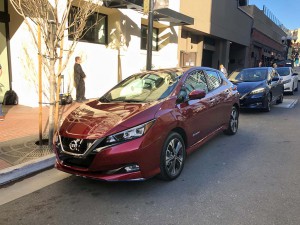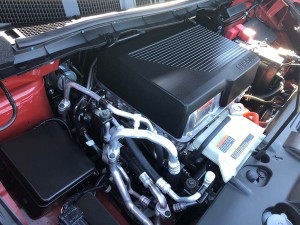It’s hard to argue against adding more power and range when you’re talking about an electric vehicle, and those are the two most significant updates to the 2019 Nissan Leaf Plus.
The original model, which made its debut nearly a decade ago, was the world’s first mass market battery-electric vehicle, or BEV. It was a revolutionary product at the time, though its relatively limited range and ho-hum performance required a fair amount of sacrifice. That has become all the more obvious as more powerful and longer-range models like the Chevrolet Bolt EV and the Tesla Models S, X and 3 have come to market.
The Japanese automaker took a half-step forward two years ago, introducing a longer, if not quite long-range, second-generation version of the Leaf. Now, it is set to play in the same league as the Bolt, Model 3 and an assortment of other new BEVs set to roll into U.S. showrooms, the Leaf Plus boosting both range and power by about 50%. The question is whether it also will give much of a boost to Leaf sales.
Up until last year, Leaf was not only the best-selling battery-electric vehicle in the U.S., but the No. 1 seller worldwide, with 380,000 of them now in customer hands. Leaf has been losing momentum, however, the U.S. sales crown last year going to the Model 3. So, the addition of the 226-mile Leaf Plus – which will be sold alongside the 150-mile version – could prove critical.
(Nissan hopes to electrify with IMs Concept. Click Here for the story.)
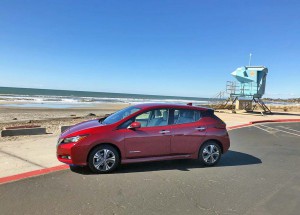
The new Leaf Plus can travel 226 miles on a single charge, putting it line with competitors like the Chevy Bolt and Tesla's offerings.
To get a sense of what’s in store, we headed out to San Diego, spending a day behind the wheel during a brief respite in what has proved to be a couple weeks of torrential rain and, in the nearby hills, even snow.
On a cool but sunny morning we slid behind the wheel, hit the “start” button and slipped our burgundy red hatchback into gear. Mashing the throttle launched us down J Street quite a bit quicker than we had expected.
The good news about battery cars is that they can deliver a truly delightful launch feel, electric motors developing maximum torque almost instantaneously, rather than having to build up RPMs, as with an internal combustion engine. That was true of the original Leaf, though it largely ran out of steam by 30 mph. Not so the new Plus model. A few minutes out from our hotel we turned onto the freeway heading east and found the 2019 model more than able to merge into traffic and then execute a fast pass by slow-moving traffic.
Such maneuvers were risky with the first-gen Nissan Leaf. A motorist had to think about absolutely every maneuver, worrying that a lead-footed launch might make it hard to get back home at the end of the day. The 150-mile gen-2 hatchback eased those worries a bit, but still limited what you could do and where you could go unless you were willing to go searching for a charging station along the way.
True, the average motorist seldom logs more than 150 miles – indeed, even 100 – on the normal day, but that’s assuming you always remember to charge up at night and don’t run into some emergency or don’t simply get the urge to make a longer trip on the spur of the moment. With 226 miles, there are far fewer situations where you’ll run into trouble.
As regular readers of TheDetroitBureau.com might recall, we’ve written a lot about the issue of range, especially the impact that things like aggressive driving, as well as hot and cold weather, will have. A pair of recent studies by AAA and Consumer Reports back up such concerns. When the weather gets down to 20, those reports noted, you could see your actual range drop by as much as half. And on a swelteringly hot day, you could lose almost 20% of range.
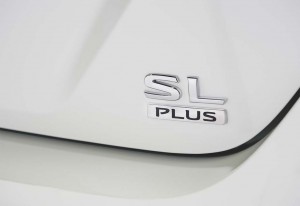
While the new Leaf gets a substantive exterior makeover, the Plus model doesn't get much differentiation from the entry-level model.
The Leaf has a particular peculiarity that can leave it especially vulnerable. Unlike most new BEVs, it uses airflow to cool its battery pack, rather than a liquid cooling system. We’ve not had a chance to check out the Leaf Plus in Michigan-style conditions, but expect it will perform much like the older versions did, in line with the sort of range loss we’ve seen on a variety of competing BEVs.
What surprised us, however, was that even when flogging the Leaf aggressively, with little effort at maximizing range, it delivered results reasonably close to those on its sticker. After clocking about 125 miles over the course of the day, we managed to pull back up to the Pendry Hotel with more than 80 miles left on the range meter. That was even more impressive considering the hilly terrain that constituted most of our route.
In terms of the technical bits, the 2019 Nissan Leaf Plus is now powered by a 62 kilowatt-hour lithium-ion battery pack. That’s 2 kWh larger than the Chevrolet Bolt EV and two less than the new Hyundai Kona EV. As the range increase would dictate, that’s just over 50% more battery than in the 2018 Leaf, with its 150-mile range. To add a bit more perspective, the original, 2011 Nissan Leaf carried a meager 24 kWh battery pack.
The current, mid-range Leaf manages to make 147 hp, while a big improvement over the original BEV, it’s no match for the 214 hp Leaf Plus. Torque, incidentally, is now rated at 250 pound-feet. The latest version continues to rely on a single permanent magnet synchronous AC motor pushing power through a single-speed gearbox.
Nissan isn’t offering specific performance numbers beyond saying you’ll hit 60 about 10% faster than with the standard-range Leaf. Our own very informal test suggested you’d be looking at something around 7 seconds. That’s not a sports car number but more than acceptable.
(Click Here for more about the studies showing the impact of hot and cold weather on EVs.)
The 2018 makeover of the Leaf saw some significant visual changes, the gen-2 model growing 1.4 inches in length, 0.8 inches in width and 0.4 inches in height. Borrowing a page from the Toyota Prius playbook, the original Nissan battery-car opted for the idea that green machines had to be fairly out there on the design spectrum. The current version is a bit more conventional but still quirky, with aerodynamic function still winning out over form with the design team.
The Plus version itself doesn’t add many design distinctions. There’s the word, “Plus” on the car’s badges, as well as blue strips on the nose and tail and a “+” on the charger cap.
Charging is pretty much the same as before but the good news is that Nissan has upgraded the car’s Level 3 capabilities, doubling the amount of current it can take to 100 kilowatts. When you’re talking about a 62 kWh battery you don’t want to plug into a 120-volt outlet unless you’re desperate. With a 240-volt charger, you’ll need to stay tethered for 11.5 hours, four hours longer than with the 150-mile Leaf. A standard, 50 kW Level 3 charger will take 60 minutes to give the new battery pack an 80% top-off. With a 10 kW charger, meanwhile, that falls to 45 minutes.
Turning back to range, there are many things that can suck down power fast, starting with headlights and the car’s climate control system. The AAA study pointedly noted that using a battery-car’s heater has a tremendously deleterious impact. Nissan has tried to reduce range loss by offering an optional heat pump system. Meanwhile, buyers can lower cabin temps and rely on the Leaf’s heated seats and steering wheel if they want to maximize range on cold days.
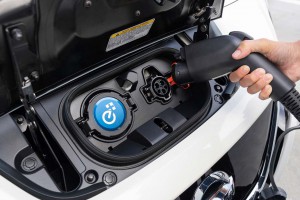
The new 2019 Nissan LEAF e+ has a 62 kWh battery pack and can be 80% charged in as little as 45 minutes.
The automaker has taken other steps to reduce current draw, with such things as low rolling resistance tires and even a high-efficiency audio system.
But it has also added an array of new advanced driver assistance systems, such as forward collision warning with auto braking, And the updated infotainment system now is paired with a larger, 8-inch touchscreen, a big improvement. Nissan now can use smartphone-like over-the-air updates, much like Tesla can, to upgrade onboard software.
Like most competitors, the system can not only be paired with a smartphone but used to remotely control a variety of vehicle functions. That includes the ability to pre-condition the cabin – warming it up on cold days, cooling it in summer – while remaining plugged in and drawing power from the grid, rather than the battery pack, to boost range.
The Leaf Plus features some minor interior upgrades, including that larger screen, but the cabin is definitely not one of the car’s strong points. It’s relatively roomy but not especially refined. Perhaps the big plus is just how quiet the Leaf is, even on a highway run topping 70 mph.
On the whole, the 2019 Nissan Leaf Plus is a big improvement over the standard-range version of the battery-electric vehicle – and that model was, itself, a big jump from the original BEV.
We expect some buyers will continue to opt for the 150-mile model to take advantage of its $29,900 base price – the lowest of any vehicle in its class. Nissan has not yet released numbers for the Leaf Plus but were expecting it to come in somewhere between $35,000 and $40,000, depending upon trim level. That would slot it in under the current Tesla Model 3 and around what Hyundai is getting for the Kona EV.
(BCG study forecasts 50% of vehicles sold in 2030 will be “electrified.” For the story, Click Here.)
Nissan needed to make the jump to a truly long-range battery-electric vehicle, and the Plus clearly has some things going for it. We doubt it will steal the thunder from the Tesla sedan but the range and performance upgrade should put it back in the game.

